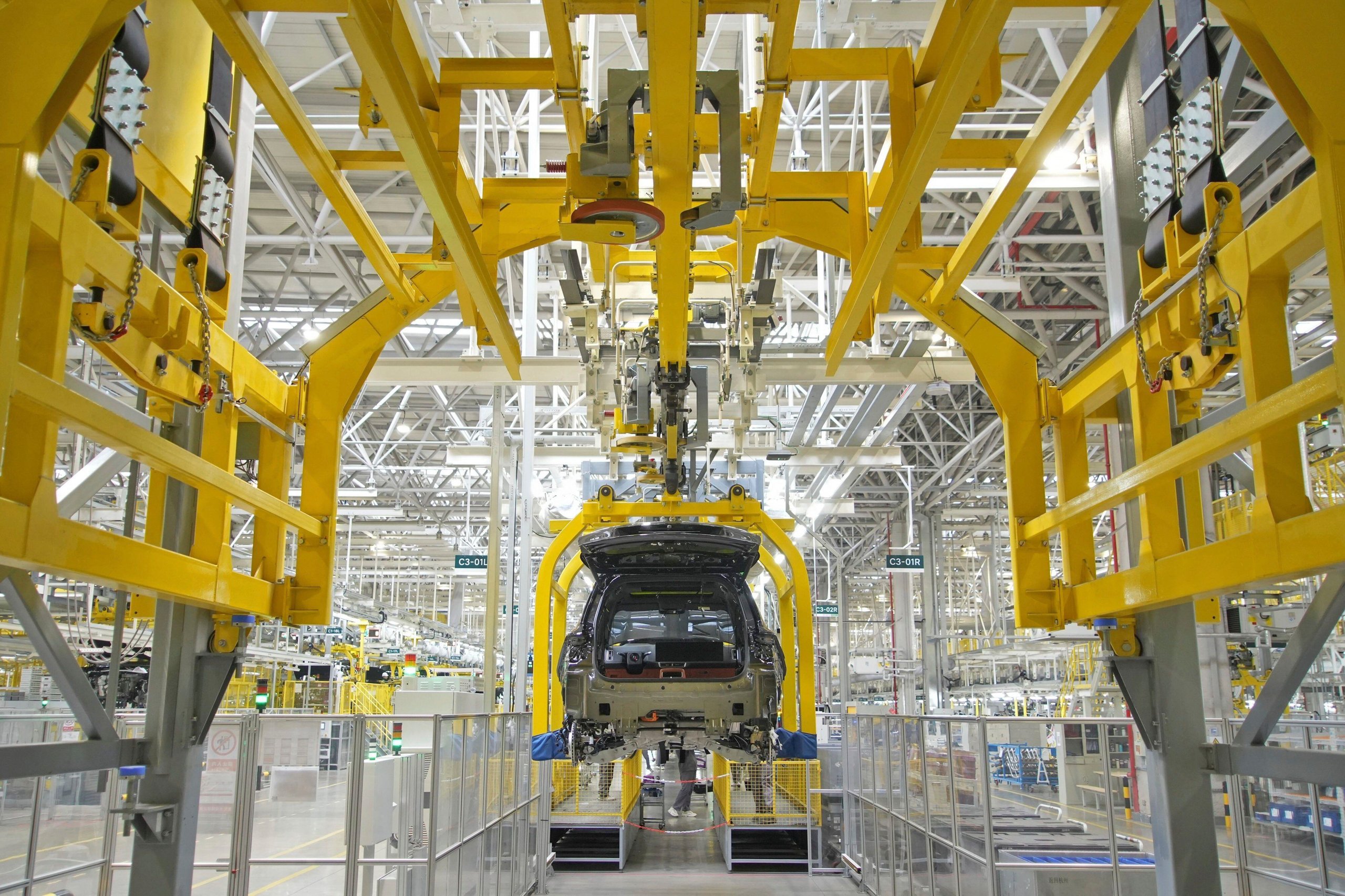Sales of electric vehicles (EVs) may be starting to slow in the US and Europe, but the Chinese market is having no such problem.
In July, EVs surpassed 50% of China’s new vehicle sales for the first time, with just shy of a million sold. That trend continued into August, when sales topped 1 million and represented 54% of all vehicle sales.
July had seen EV sales grow 27% year-on-year while internal-combustion engine (ICE) sales declined markedly. August ICE sales were down 28% year-on-year, which also helped to boost EV market share.
Despite this good news, there may be danger up ahead. Well-substantiated allegations of industrial overcapacity and state support have led the US, EU, and Canada to bring in tariffs on Chinese-made EVs. There is a risk those tariffs will spread to other nations such as Brazil, where imports surged last year.
Domestically, overcapacity has hit China’s auto industry hard, though the most pronounced effects have been felt in ICEs, according to the New York Times [$]. Now, the increasing hostility in foreign markets threatens to increase the problem in China’s EV industry and intensify an already fierce price war.
As industry leaders confront these problems, rural Chinese sales may offer a potential solution.
Risk and opportunity in the countryside
Rural areas have tended to lag behind urban centres when it comes to EV sales. This is partly because Chinese EV makers have a greater understanding of what urban consumers want. Anders Hove, senior fellow at the Oxford Institute of Energy Studies, says rural Chinese drivers “are typically lower income, have less predictable driving patterns, and are more price conscious” than their urban counterparts. Though many rural Chinese people do already own two- and three-wheeled EVs, Hove notes.
From the perspective of Chinese EV makers, this landscape presents both risk and opportunity. Existing EV models are largely tailored to urban driving habits. The investment necessary to build models with rural consumers in mind might not pay off. Between 2022 and 2023, EV market penetration in rural areas more than quadrupled, from 4% to 17%. But that still significantly trails the national rate.
The opportunity comes in the sheer size of the market. At 500 million people, China’s rural market is bigger than the entirety of the EU’s, explains Cory Combs, associate director at Trivium China, a Beijing-based research group. “If any brand were to tap that potential, the opportunity is huge.”
But doing so presents a challenge for both policymakers and private-sector leaders. “Developing the charging infrastructure is expensive, and the return on investment is still minimal,” Combs notes.
Nationwide growth in EV sales has remained lethargic despite price cuts, meaning costs can’t be the only issue. BYD, the world’s largest EV manufacturer, sells its cheapest model for less than USD 10,000. Some estimates suggest that EVs are already cheaper in China on average than ICEs.
Combs says that when EVs were much more expensive relatively, it was easy to put low rural uptake down to price-conscious consumers. “Now that the price differential is negligible, that we haven’t seen a bigger jump in rural EV sales points to the fact that there are more structural barriers to rural consumers buying EVs.”
One persistent challenge to EV uptake worldwide is charging infrastructure. China leads the world in installations but these are concentrated in urban areas where EV market penetration is already high. Of the 3.12 million public charging stations nationwide, the vast majority are in eastern provinces like Guangdong, Zhejiang, and Jiangsu.
Remedying this problem is challenging. Most of China’s infrastructure development has been dominated by state-owned enterprises, but roughly 90% of public chargers in China are owned and operated by private companies. This makes the industry significantly profit-sensitive.
The lack of EV owners makes the business case for building a charging pile in rural China quite weak. This chicken-and-egg dynamic, where low EV sales stop companies from investing in charging infrastructure and the lack of charging infrastructure stops people buying EVs, is unlikely to resolve itself naturally.
Response from policymakers
One way to cut the Gordian knot is through increased government spending. At the central level, policymakers have been long on ambition and short on stimulus.
This year’s Central Committee No. 1 Document – an annual policy statement focusing on rural issues – identified rural EV charging infrastructure as a development priority for the first time. Yet state-owned enterprise’s are building a small and decreasing share of new public charging piles. The two primary public utilities involved in building charging stations – State Grid Corporation of China and China Southern Power Grid – saw their share drop from nearly 15% of public chargers in 2023 to 10% in 2024.
This aligns with central policymakers’ broader approach to China’s economic growth. At a World Economic Forum event in Dalian in late June, Premier Li Qiang announced that China was unlikely to turn to government spending to accelerate GDP.
At the local level, officials have taken up the mantle of building out charging infrastructure. But their strategy is geared more towards incentivising private companies than doing it themselves.
One example is Yunnan, an economically less-developed province with a large rural population. EV market penetration rate was 23% in 2023, significantly lower than the national average. Late in that year, local leaders pledged to reach at least 60,000 public charging stations by the end of 2025, though data from June shows the number had already exceeded 59,000, revealing the modesty of that target. This indicates that Yunnan policymakers are not hopeful they can persuade the private sector to accelerate their efforts, and don’t have the capacity to do it themselves.
Local governments in China are struggling with debt. New estimates from the University of San Diego put total local government debt in the range of CNY 90-110 trillion (USD 12.7-15.5 trillion), or between 75% and 91% of China’s GDP in 2022. Combs agrees with this analysis. “Spending on charging infrastructure might boost consumption in five years, but they need it to go up today,” he says, referencing consumption’s knock-on economic benefits.
What seems more promising is collaboration between central and local government. In April, three central ministries announced a pilot project that aims to select 70 counties across 24 provinces and award them each up to USD 6.3 million to develop EV battery charging and swapping infrastructure. The central government will pay out at least 70% of the award money, with the rest coming from the relevant local government.
If 70 counties are selected and they all receive the full award, this would be a significant step in subsidising rural charging infrastructure. But it isn’t yet clear what the total award amount will be in the end, and nothing will be paid out until the end of 2026 at the earliest. So the direct, short-term impact is likely to be minimal.
It does however send a strong signal to the market that all levels of government are behind increasing rural EV consumption. The result may be that private-sector firms take the first steps in bolstering rural charging infrastructure.
How the private sector is responding
Felix Ye, senior supply chain manager at a large Chinese EV maker, says production and consumption factors do make it possible to increase rural EV market penetration. On the production side, Ye says, better “domestic supply chains and larger-scale manufacturing have lowered costs”. While on the demand side, “urban residents moving to rural areas have raised per capita GDP”.
These changes are allowing EV makers like NIO and Huawei to emerge as another source for rural charger development.
NIO, which I have written about before, has built a network of chargers and battery-swapping stations all across China. Its ChargeMap locates swapping stations nationwide and includes suggestions for how drivers can use its stations to take long road trips, as far as deep into Xinjiang. For its part, Huawei, which has recently released an EV, is building a network of fast-charging stations and has pledged to extend coverage to Chinese rural areas.
For companies like NIO and Huawei, the goal is probably not to generate revenue through rural charging stations. They aim is to improve the user experience for their primarily urban consumers who want to travel throughout China. For rural EV consumers, the effect is the same.
Crafting the right incentive scheme
More charging infrastructure, coupled with financial incentives from local governments, could encourage people in rural China to purchase EVs. That in turn could improve the business case for other charging companies to build more infrastructure, potentially creating a virtuous cycle.
Regardless of the specific contents of a successful incentive scheme, increasing EV sales in rural areas feels like a question of “when” not “if”. Rural EV consumption growth would represent progress towards so many high-level policy goals, from building out a first-class EV manufacturing industry, to rural revitalisation, decarbonisation, boosting consumer demand, and building a “moderately prosperous society”. The synergies are hard to miss.








